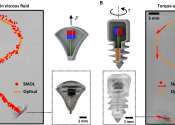Magnetic field patterns found to cause oncolysis via oxidative stress in glioma cells
Anticancer treatment strategies increasingly seek to raise reactive oxygen species (ROS) levels, cause macromolecular damage, and kill cancer cells. Electromagnetic fields can elevate intracellular reactive oxygen species ...








